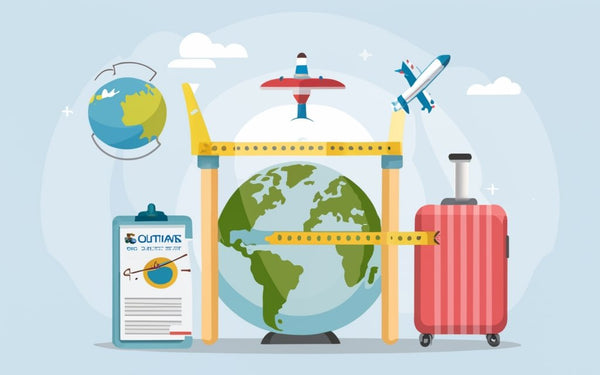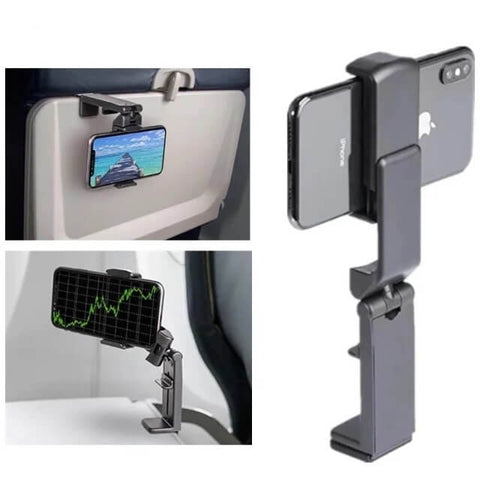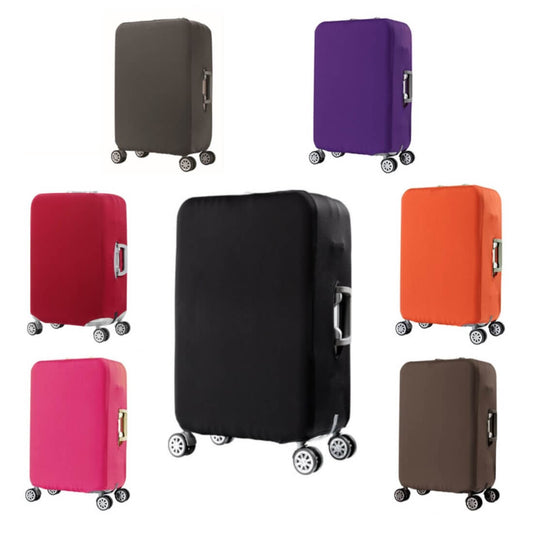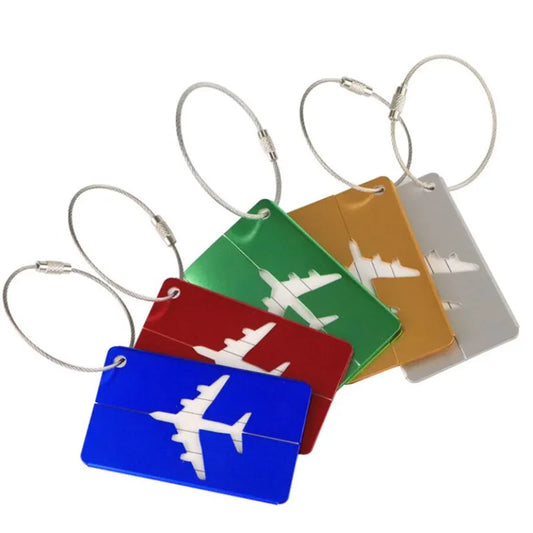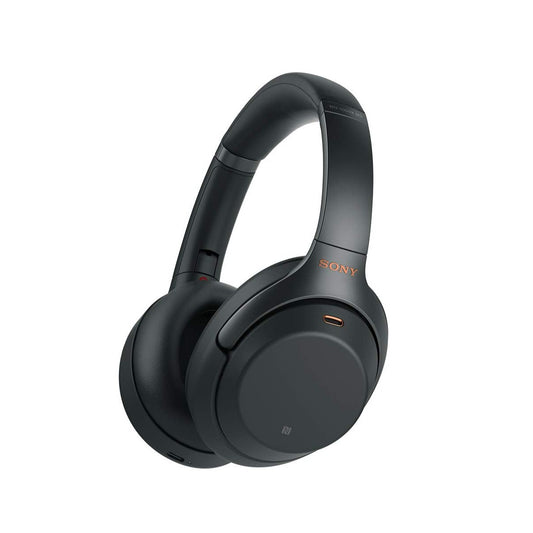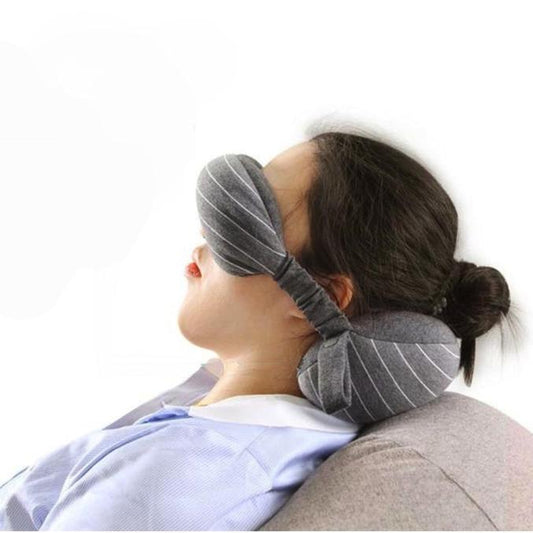Amazon affiliate links may earn a commission
Airline Luggage Size Chart for Maximum Size of Personal Items and Checked Bags
| Airline | Appropriate Carry-on Suitcase | Carry-on Size | Carry-on Weight | Checked Bag Size | Checked Bag Weight |
|---|---|---|---|---|---|
| American Airlines | LUGGEX Carry On Luggage 22x14x9 | 22 x 14 x 9 inches | 40 pounds | 62 inches (linear dimensions) | 50 pounds |
| Delta Air Lines | LUGGEX Carry On Luggage 22x14x9 | 22 x 14 x 9 inches | 40 pounds | 62 inches (linear dimensions) | 50 pounds |
| United Airlines | LUGGEX Carry On Luggage 22x14x9 | 22 x 14 x 9 inches | 40 pounds | 62 inches (linear dimensions) | 50 pounds |
| Southwest Airlines | Coolife Luggage Suitcase 23x15x9.4 | 10 x 16 x 24 inches | 35 pounds | 62 inches (linear dimensions) | 50 pounds |
| Spirit Airlines | Take OFF Luggage 18x14x8 | 18 x 14 x 8 inches | 18 pounds | 62 inches (linear dimensions) | 40 pounds |
| Frontier Airlines | Take OFF Luggage 18x14x8 | 18 x 14 x 8 inches | 20 pounds | 62 inches (linear dimensions) | 40 pounds |
| Allegiant Air | Wrangler Underseat Spinner 15x13x8 | 17 x 15 x 8 inches | 40 pounds | 62 inches (linear dimensions) | 40 pounds |
| JetBlue Airways | Coolife Luggage Suitcase 23x15x9.4 | 24 x 16 x 10 inches | 25 pounds | 62 inches (linear dimensions) | 50 pounds |
| Alaska Airlines | LUGGEX Carry On Luggage 22x14x9 | 22 x 14 x 9 inches | 40 pounds | 62 inches (linear dimensions) | 50 pounds |
| Air Canada | LUGGEX Carry On Luggage 22x14x9 | 22 x 14 x 9 inches | 40 pounds | 62 inches (linear dimensions) | 50 pounds |
Please note that this luggage size chart is a snapshot. Keep in mind, many airlines may have different restrictions by the time you read this. It is always best to check with your airline directly before traveling to ensure that your carry-on luggage meets their size requirements.
Luggage Bungee to Secure Personal Item to Suitcase ›
Greetings, fellow travelers and travel enthusiasts! Have you ever stood in the suitcase aisle or collection, surrounded by a sea of extensive suitcase sizes and options, and wondered, "What size of large suitcase do I need?"
Fear not, as we have our ultimate luggage size charts. Let's demystify the daunting task of choosing the perfect-sized suitcase. Possibly one of the most important guides for any adventure.
📏 How to Measure Luggage Size
Size is one of the most important factors highlighted in our guide to luggage sizes when buying or packing carry-on suitcases. Airlines have different size restrictions and checked luggage fees for carry-on suitcases and check-in luggage.
Indeed, no
Our best carry-on luggage guide will elaborate on the fundamental principles of measuring luggage size, offer some valuable tips and common blunders to avoid, and present solutions for managing irregularly shaped luggage pieces that may impact your flight plans.
Understanding the Dimensions
As a dedicated, the first important thing you must grasp is the method of reading the size dimensions of your hand luggage.
The cabin bag's length, width, and height represent the dimensions of your carry-on hand luggage. These numbers represent the external measurements, including the wheels, handles, and pockets.
The order of the numbers may vary, but the most significant number is always the length, the second largest is the width, and the smallest is the height of the cabin bag.
For example, if the maximum dimensions of your suitcase are 22 x 14 x 9 inches, it is well within the most common baggage limit.
Airlines can also collectively express these dimensions of their suitcase as linear inches, which would be the sum of these three measurements. Ideally, the baggage size falls under the standard suitcase limit of 62 inches. In this case, your suitcase would have a linear size of 45 inches (22+14+9).
Measuring Your Luggage Bag
You will need a measuring tape and a flat surface to measure your luggage size. Follow these steps to get the correct measurements:
- Place your luggage on a flat surface and ensure it is fully zipped and closed.
- Measure the length of your suitcase from the bottom to the top, including the retracted wheels and the compressed handle, in the upright position. Record this number as the length.
- Measure the width of your bag from side to side, including any external pockets or protrusions. Record this number as the width.
- Measure the height of your luggage from front to back, including any external pockets or protrusions. Record this number as the height.
- If checking the bag, add the three numbers to get the linear size of your suitcases.
Tips for Accurate Measurements
Here are some tips to help you plan ahead and avoid any surprises at the airport:
- Check the dimensions of your suitcase on the manufacturer's website or the product tag as the starting point.
- Measure your suitcase after you pack it to get actual measurements, as the contents may expand the size of your bag.
- Compare your measurements with the size limits of your flight. You can find the up-to-date size limits on the airline's website or by contacting customer service.
- Allow some margin of error for your measurements, as the airport staff may use different measuring devices or methods.
Common Mistakes in Measuring for Maximum Size
Some common mistakes that people make when measuring:
- You are measuring the internal dimensions instead of the external dimensions. This can result in underestimating your luggage's size and exceeding your airline's size limits.
- You are measuring the diagonal length instead of the linear length. This can result in overestimating and missing out on some space.
- Measuring the suitcase with the handle extended or the wheels protruding. This can result in inaccurate measurements and extra fees. Always measure your suitcase with the handle retracted and the wheels flush with the body. If each wheel is fixed, include them in the measurement.
Dealing with Irregularly Shaped Luggage and Personal Items
Some luggage may have irregular shapes that make it difficult to measure them accurately. For example, backpacks, duffels, golf bags, skis, etc. In these cases, you can use the following methods to estimate the size:
- Use a box or a container that can fit your odd-shaped bag, and measure the dimensions of the box or container. This will give you an upper bound of the size of your luggage.
With their often large size, most airlines won't use irregular luggage to be counted for free checked bags. When possible, pack everything inside the suitcase.
Measuring Luggage Weight
When traveling, it is essential to know the exact weight of your luggage to avoid overweight fees at the airport. Here are some tips on how to accurately measure luggage weight:
- Use a Luggage Scale. Using a digital luggage scale is the easiest way to know the weight. These small, portable scales can be hooked onto the handle of your suitcase and will display the weight in pounds or kilograms.
-
Use a Body Weight Scale. You can use a body weight scale if you do not have a luggage scale.
- First, weigh yourself without holding anything. Make a note of your weight.
- Pick up your packed bag and step on the scale again while carrying the bag.
- Subtract your weight measured first from the new weight shown on the scale.
- The difference is the approximate weight of your bag. Note that digital body weight scales may have slight margins of error.
- Weigh each piece of luggage separately to ensure none exceed the airline weight limits.
Using an accurate luggage scale is the best method, but the body weight scale technique can also work in a pinch. Weigh your bags before heading to the airport to prevent any overweight surprises!
💺 Carry-On Luggage Size Restrictions
Suitcases can be brought on the plane, and most carriers allow passengers to store them in the overhead bin, which can accommodate a medium-size suitcase or under the seat for a small bag or personal item that is carry-on size.
Carry-on baggage is convenient and cost-effective, as you can avoid check-in fees, baggage claim delays, and lost or damaged suitcases. However, airlines also have size restrictions for carry-ons.
This section will explain the general carry-on luggage size restrictions for many airlines and offer tips and strategies for maximizing your carry-on space. Otherwise, check out the airline carry-on luggage size chart above. We can't cover all the airlines, so check with your airline's websites for their weight and size allowed per bag amount.
Guidelines for Personal Items
In addition to your carry on luggage, you can usually bring one personal item on the plane without additional charges. We don't mean a personal item like your phone charger, lithium batteries, or a deck of playing cards.
A personal item is a smaller cabin bag or non-standard-size item brought on board that can fit under the seat in front of you. Individual items are purses, laptop bags, backpacks, briefcases, duffel bags, camera bags, etc.
A personal item also has size restrictions that vary for specific airlines, routes, and the type of flight. The average individual item limit is 17 x 13 x 8 inches, or 45 x 33 x 20 cm. However, some airlines may have lower or higher limits depending on their policies and preferences.
Carry-On Weight Limit Considerations
Carry-on weight limit considerations are the factors you must consider when packing your carry-on luggage. Considerations vary depending on the airline, the route, and the type of flight. They may also depend on your luggage's size, weight, and category.
Considerations may include:
-
Carry-on weight limit: The maximum weight that your carry-on suitcase can be has to be accepted by your airline.
- This may range from 15 to 40 pounds or 7 to 18 kilograms, depending on the airline, the route, the type of flight, and if it's a personal item.
- You should always check your airline and flight before you pack your bag and weigh your suitcase accordingly.
-
Carry-on weight distribution: Some airlines may have a combined limit for your carry-on luggage and personal items, while others keep them separate.
- You should always check the carry-on weight distribution of your airline and your flight before you pack your personal item bag and balance it accordingly.
You should always consider the carry-ons' full-on weight impact on your luggage before you pack your luggage, and fill your carry-on bags as lightly as possible.
Avoiding Size Penalties and Fees for Your Carry-on Suitcase
If the size of your carry-on luggage or personal item exceeds the limit of your airline, you may face penalties and fees at the airport. These penalties and fees may include:
- You may have to check in your luggage and pay the checked bag fees, ranging from $25 to $200 per bag, depending on the airline, the route, and the size of your suitcase.
- You may have to pay the oversized or overweight fee rates for checked bags, which can range from $50 to $500 per bag, depending on the airline, the route, and the weight of your luggage.
Alternatively, you may have to leave behind a large suitcase and some of your belongings or discard them at the airport, which can cause inconvenience and frustration. To avoid these penalties and fees:
- Use a luggage scale to weigh your suitcase and compare if you're in the weight allowances. This will help you avoid overweight fees.
- You should always measure your suitcase size after you pack it, compare it with the suitcase size limit of your airline, and adjust it accordingly.
- You should also check the size of your suitcase or personal item at the airport using the measuring devices or bins provided by the airline staff.
If the standard size of your suitcase is slightly over the suitcase limit, you may be able to squeeze it or rearrange it to fit the suitcase size limit. However, if the size of your luggage is significantly over the limit, you may have to pay the fees or check in your luggage.
📐 Understanding Checked Luggage Sizes
Checked luggage is the suitcases you check-in at the airport and retrieve at the baggage claim.
Checked luggage is suitable for longer trips, more oversized items, or items not allowed in the carry-on luggage. However, checked luggage also has size restrictions that vary depending on the airline, the route, and the type of flight.
This section will explain the generally reviewed luggage size restrictions and offer tips and strategies for avoiding oversized fees.
Maximum Size and Weight Allowance Restrictions on Different Airlines
The airline, the route, and the type of flight determine the maximum size and weight allowance for a checked suitcase.
The airlines usually give the max size baggage allowance amount in linear inches, which is the sum of your luggage's length, width, and height.
Most airlines will have an average full size and weight allowance for a checked suitcase of 62 linear inches and 50 pounds, or 28 kilograms. However, some airlines may have lower or higher limits depending on their policies and preferences.
Many airlines allow you to check bags up to 70 lbs, or 32 kg, although often with extra fees. Check out the cheat sheet luggage chart above for our snapshot of current allowances.
Weight and Size Restrictions for Checked Bags
Weight and size restrictions for cabin or checked bags are the limits your checked luggage must meet to be accepted by your airline.
Weight and size restrictions for checked bags may vary depending on the airline, the route, and the type of flight. They may also depend on your luggage's size, weight, and category.
Weight restrictions and size restrictions for checked bags may include:
-
⚖️ Maximum weight allowance: The weight of checked luggage accepted by your airline.
- Max weight for most airlines ranges from 50 to 70 pounds or 23 to 32 kilograms, depending on the route and the type of flight.
-
📏 Maximum size allowance: The size of checked luggage accepted by your airline.
- Maximum size allowance is usually given in linear inches, the sum of your luggage's length, width, and height.
- Maximum size allowance may range from 62 to 80 linear inches, depending on the airline, the route, and the type of flight.
You should always check the airline and flight allowances before you pack your suitcase and measure your bag accordingly.
Strategies for Avoiding Oversized Fees
If your checked luggage exceeds the size limit of your airline, you may face oversized fees at the airport.
The average hefty fee for checked luggage is $100 per bag, but it can range from $50 to $500 for some airlines.
To avoid these fees as a customer, you should always measure your luggage size after you pack it, compare it with the size limit of your airline, and adjust it accordingly.
You should also check the size of your personal item or suitcase at the airport using the measuring devices or bins provided by the airline staff.
If your bag is slightly over the limit, some airlines may allow you to squeeze or rearrange it to fit the size limit. However, if your bag is significantly over the limit, you may have to pay the extra fees or check in another bag.
🛬 Airline Baggage Policies and Restrictions
Airline baggage policies and restrictions are the rules and regulations that govern the luggage that you can bring on the plane.
These policies and restrictions may vary depending on the airline, the route, and the type of flight.
Suitcase sizes may differ if you're in basic economy or first class.
Airlines may change them over time for security, safety, or operational reasons.
Guide Chart to Baggage Fees
You often have to pay baggage fees to bring luggage on the plane. Baggage fees vary with the airline, the route, and the type of flight.
Airlines usually won't charge this as part of your ticket price but as a separate charge on your credit card.
Baggage fees may include:
-
Check-in fees: The fees you pay to check your suitcase at the airport.
- Check-in fees may apply to your first, second, or additional checked bags, depending on the airline and the flight.
- Some airlines' check-in fees may range from $25 to $200 per bag.
-
Oversized fees: The fees you pay for bringing suitcases that exceed the size limit of your airline.
- Fees may apply to your carry-on luggage or checked bag.
- Oversized fees may range from $50 to $500 per bag, depending on the airline, the route, and the larger size of your luggage.
-
Overweight fees: Airlines charge you for bringing bags that exceed their weight restrictions.
- Heavy fees may apply to your carry-on luggage or checked bag.
- Hefty fees may range from $50 to $500 per bag, depending on the airline, the route, and the weight of your bags.
-
Special service fees: Sometimes, airlines require you to pay for bringing luggage that belongs to a particular category or bulky items.
- Items such as sports equipment, musical instruments, or medical devices.
- Special fees may apply to your carry-on bag or checked suitcase.
List of Restrictions
When packing for a flight, certain items are restricted from being included in your carry-on luggage or checked bags for security reasons. Here is an overview:
Items Generally Restricted from Carry-on Bag:
- Sharp objects such as knives, box cutters, scissors, or metal nail files
- Sporting goods such as baseball bats, golf clubs, hockey sticks, or lacrosse sticks
- Firearms, ammunition, and explosive devices
- Flammable liquids such as fuels, solvents, lighter fluid
- Chemicals including bleach, spray paint, fertilizer
- Self-defense items like mace, pepper spray
Items Generally Restricted from Checked Luggage:
- Perishable items like fresh produce, meat, and dairy as contents may spoil
- Items containing lithium batteries, which can ignite
Every airline must also comply with the TSA; read their What Can I Bring Page for more.
This varies a lot, especially for international flights for safety reasons. Be sure to check with your airline for specific restrictions before packing carry-on or checked baggage.
Prohibited items found during security screening may be confiscated, or you may face additional screening. Declaring restricted items upfront prevents unnecessary delays or penalties.
🌎 Essential Considerations for International Flights
International airlines operate flights that cross national borders or regions.
Domestic airlines operate flights within the same country or region.
Domestic Airlines
Domestic Airlines have more flexibility and consistency in their operations and regulations. Flying domestically will generally allow you to bring something larger; however, some major airlines may have lower or higher limit policies and preferences. See the suitcase size chart above for the dimension limits.
International Airlines
International airlines usually have stricter limits than domestic airlines, as they must comply with other countries' or authorities' regulations and customs. International flights may also have challenges and risks that differ from domestic flights, such as different aircraft, longer travel time, jet lag, currency exchange, language barriers, cultural differences, etc.
Check the baggage policies and restrictions of your destination country or region. Different countries or regions may have different rules and regulations for the luggage you can bring into or out of their territory. These rules and regulations may include the weight allowed and size limits, the number of bags, the fees and taxes, the prohibited or restricted items, the declaration and inspection procedures, etc.
You should check the baggage policies and restrictions of your destination country or region before packing your suitcase and traveling and follow them accordingly. You can find the baggage policies and regulations of your destination country or area on the official website of their government, embassy, consulate, or tourism board or by contacting their customs or immigration office.
🤔 Choosing the Right Luggage to Use During Your Next Travel Trip
Choosing the right luggage for your travel needs is one of the most important decisions before traveling. The right suitcase can make your travel experience more enjoyable, comfortable, and convenient, while the wrong one can cause problems, frustrations, and inconveniences.
The right luggage depends on various factors, such as your travel destination, duration, purpose, budget, style, and preference.
This section will explain the factors you should consider when selecting luggage, the best luggage and suitcase size for your trips, the pros and cons of hard side vs. soft side suitcases, and how to customize your luggage and suitcase size fits you for specific travel requirements.
Benefits of Choosing the Best Suitcase Size Dimensions
Choosing the right luggage size for your next trip can have many benefits:
- 💵 Saving money on baggage fees and oversized fees.
- ⌚ Saving time and hassle at the airport and the baggage claim.
- 🌌 Saving space and weight in your bag.
- ✈️ The ease and speed of boarding and deplaning.
- 💺 The availability and accessibility of the overhead bin or under-seat space.
- 🛄 The maneuverability and portability of your luggage.
- 💪 The strain and fatigue on your body and muscles.
- 🔐 The safety and security of your belongings.
Factors to Consider When Selecting Baggage Size
When selecting your own size of luggage, you should consider the following factors:
-
Your travel destination: Your travel destination may affect the type, size, and weight of your suitcase, as different destinations may have different weather, terrain, culture, and regulations.
- For example, if you are traveling to a cold or rainy destination, you may need larger and heavier suitcases to pack your warm and waterproof clothes and accessories.
- If you travel to a conservative or religious destination, you may need modest and respectful bags that do not offend the locals or violate their customs.
-
Your travel duration: Your travel duration may affect the amount and variety of your luggage, as different durations may require different levels of preparation and planning.
- For example, if you are traveling for a short trip, you may only need a small and light bag that can fit your essentials and save you time and money.
- If traveling for a long journey, you may need a large, heavy suitcase to hold your clothes and accessories for different occasions and activities.
- If traveling indefinitely, you may need versatile and adaptable luggage that suits your changing needs and preferences.
-
Your travel purpose: Your travel purpose may affect the style and function of your luggage, as different purposes may demand different expectations and impressions.
- For example, suppose you are traveling for a business trip. In that case, you may need professional and elegant bags to accommodate your laptop and documents and impress your clients and colleagues.
- Traveling for leisure may require casual and fun suitcases to express your personality and enhance your enjoyment.
- If you are traveling for a particular trip, you may need unique and memorable luggage that can reflect your theme and mood.
-
Your travel style: Your travel style may affect the personalization and customization of your luggage, as different styles may reflect different tastes and preferences.
- For example, a minimalist may prefer simple, sleek bags that fit your essentials and avoid clutter and excess.
- If you are a maximalist, you may choose a complex and elaborate suitcase that can hold your extras and express your flair and creativity.
- If you are a hybrid, you may prefer flexible and modular bags that adapt to your needs and preferences.
-
Durability: You want your luggage to last for many trips and withstand the wear and tear of travel.
- Look for sturdy luggage, solid zippers and handles, and smooth wheels on different surfaces. Avoid suitcases that are cheaply made, have flimsy parts, or have wheels that are prone to breaking.
-
Security: You want your luggage to protect your belongings from theft, damage, or loss.
- Look for suitcases with locks, zippers that can be secured, and hard shells that resist punctures. Avoid bags that are easy to open, have exposed zippers, or have soft sides that can be cut or torn.
-
Comfort: You want your luggage to be easy to carry, maneuver, and store.
- Look for suitcases that have ergonomic handles, adjustable straps, and lightweight frames. Avoid suitcases that are too heavy, bulky, or awkward to handle.
-
Style: You want your luggage to suit your taste and preference.
- Look for luggage with colors, patterns, and designs you like. Avoid luggage that is bland, boring, or outdated.
Determining the Best Suitcase Size for Your Trips
The best luggage size for your trips depends on several factors, such as the length of your trip, the type of your trip, the climate of your destination, and the airline baggage policies.
Here are some general guidelines for choosing the right bag size for your trips:
- Short trips: You can usually get by with carry-on luggage and a personal item for trips that last a few days or a week. These sizes allow you to travel light, avoid checked fees, and access your belongings easily.
-
Long trips: You may need checked and carry-on luggage for over a week.
- Checked luggage is typically for more clothes, shoes, and accessories. These sizes allow you to pack more but require you to pay checked baggage fees and wait for your bags at the baggage claim.
- A carry-on luggage is still helpful in keeping your essentials, valuables, and fragile items.
-
Special trips: For particular activities, equipment, or items, you may need a specific luggage size or type. These sizes and types allow you to carry your special items but also have their limitations, such as weight, shape, and availability.
- For example, if you are going on a ski trip, you may need a ski bag to fit your skis, boots, and poles.
- If you are going on a business trip, you may need a garment bag to keep your suits and dresses wrinkle-free.
- If you are going on a camping trip, you may need a backpack to hold your tent, sleeping bag, and other gear.
Comparing Hardside vs. Softside Suitcases
Another factor to consider when choosing a suitcase is whether to go for the hard or soft side type.
- 🧳 Hard-side suitcases are made of rigid materials like polycarbonate, aluminum, or ABS plastic.
- 💼 Soft-side bags are made of flexible materials like nylon, polyester, or leather.
Here are some pros and cons of each type:
-
Hardside Suitcases:
- ✅ Pros: Hardside luggage is more durable, secure, and resistant to water and stains. Hard-shell suitcases can protect your belongings from impact, puncture, and moisture. It can also retain shape and size, regardless of how much you pack.
- 🚫 Cons: Hardside suitcases are heavier, bulkier, and more expensive than soft-side luggage. It can also be more prone to scratches, dents, and cracks. Fitting in tight spaces, such as standard cabin overhead bins, car trunks, or hotel closets, can be more challenging.
-
Softside Bags:
- ✅ Pros: Softside suitcases are lighter, more flexible, and more affordable. It can also expand to accommodate more items and compress to fit smaller spaces. It can also be easier to access and organize, as it often has external pockets and compartments.
- 🚫 Cons: Softside suitcases are less durable, secure, and resistant to water and stains. It can also lose shape and size depending on how much you pack. It can also be more vulnerable to damage, such as tears, cuts, and spills.
🛩️ Strategies for Maximizing Carry-On Limited Space
One of the challenges of traveling with carry-on luggage is getting more space and packing everything you need in a limited suitcase space.
Here are some strategies and packing tips to help you maximize your carry-on space and make the most of your luggage space:
-
📝 Make a packing list and prioritize your essentials.
- A packing list can help you plan and organize your packing and avoid forgetting or overpacking items.
- It would be best to prioritize your essentials, such as your passport, tickets, medications, toiletries, underwear, etc.
- You should also consider the weather, the culture, and the activities of your destination and pack accordingly.
-
🛍️ Choose the right luggage size and shape for your trip. Depending on the length and purpose of your journey, you may need a different luggage size and shape.
- For example, if you are traveling for a short trip, you may only need a small carry-on bag that can fit under the seat.
- If traveling for a long journey, you may need a giant carry-on suitcase that can fit in the overhead bin.
- If you are traveling for a business trip, you may need a carry-on bag to accommodate your laptop and documents.
- If you travel for a leisure trip or vacation, you may need a carry-on bag to hold your clothes and accessories.
-
👝 Use packing cubes or compression bags to organize and compress your belongings into the main compartment.
- Packing cubes are small containers that can help you sort and pack your belongings neatly and compactly.
- Compression bags help you save space by compressing the air out of your clothes and reducing the volume of your suitcase.
- You can use different cubes or bags for items such as clothes, shoes, toiletries, electronics, etc.
- You can also use different colors or labels to identify the contents.
-
🗞️ Use the roll or bundle method to pack your clothes. The roll or bundle method is a technique of packing your clothes to help you prevent wrinkles and save space.
- Roll involves rolling your clothes into tight cylinders and stacking them in your suitcases.
- The bundle method involves wrapping your clothes around a core item, such as a pillow or a sweater, and creating a bundle that fits your suitcase.
- Both methods can help you pack more clothes in less space and avoid creases and folds.
-
🧥 Wear your heaviest and bulkiest items on the plane. Another way to save space in your carry-on luggage is to wear your heaviest and bulkiest items on the plane instead of packing them in your suitcase.
- These items may include your coat, boots, sweater, jeans, etc.
- Wearing these items can also help you stay warm and comfortable on the plane, as the temperature may vary during the flight.
- Be prepared to take off or put on these items as needed, depending on the security checks and the climate of your destination.
-
👟 Use the space inside your shoes and other items.
- You can fill the space inside your shoes with socks, underwear, jewelry, or other small items.
- You can also use the space inside your hat, mug, toiletry bag, or laptop bag to store some of your belongings. This can help you utilize every inch of your carry-on luggage.
-
🎒 Pack your essential items in your carry-on luggage.
- You may face delays, cancellations, or losses of your checked luggage for various reasons, such as weather, security, logistics, or human error.
- To avoid being stranded or inconvenienced without your essential items, pack them in your carry-on luggage and always keep them with you.
- Your essential items may include your passport, tickets, visas, documents, medications, toiletries, valuables, electronics, etc.
- It would be best to pack some spare clothes, snacks, and entertainment in your carry-on luggage in case of lengthy flights or layovers.
-
🧅 Packing in layers can help you optimize your luggage space and protect your items from damage.
- Packing in layers involves placing your heaviest and bulkiest items at the bottom of your suitcases, your medium-weight and medium-size items in the middle, and your lightest and smallest items at the top. This can help you balance the weight and distribution of your suitcase and prevent your items from shifting or crushing.
-
🏷️ Label your luggage clearly and securely.
- To prevent your luggage from being lost, stolen, or mixed up with other passengers' suitcases, you should label your luggage clearly and securely.
- You should attach a luggage tag or a sticker with your name, address, phone number, email, and flight information to each suitcase and bag.
- You should also use a lock, a strap, or a seal to secure your luggage and deter thieves or tamperers.
- You should also use a distinctive color, pattern, or accessory to make your suitcase easily identifiable.
- 📃 Because the external label can be damaged or removed, you should include a copy of your itinerary and contact details inside your luggage.
- 🎁 If you plan on buying souvenirs while on your trip, leave some capacity to bring them back unless you plan on shipping them back or using an extra suitcase.
🏁 Conclusion to this Luggage Size Guide
And there you have it, friends - a comprehensive guide to demystifying the world of luggage sizes! From measuring techniques to packing strategies and specific airline regulations, we have covered all the details to select the perfect carry-on medium-size, hard-shelled, large suitcase you'll likely take on your next beach holiday.
Remember these tips as you venture on your next trip and long-haul adventure. Consider your destination, duration, and packing requirements before deciding on suitcase dimensions. Confirm any size and weight restrictions to avoid unpleasant surprises. Use space-saving techniques for suitcases like bundles, suitcases, cubes, and compression bags. And don't forget - the right-sized luggage can make all the difference in the journey!
With the knowledge you've gained today, you can confidently take to the skies, breeze through TSA security checks, and relax, knowing all your belongings and suitcases are safe and secure, hopefully without a business travel insurance card. We wish you smooth sailing and happy trails wherever your travels take you!

